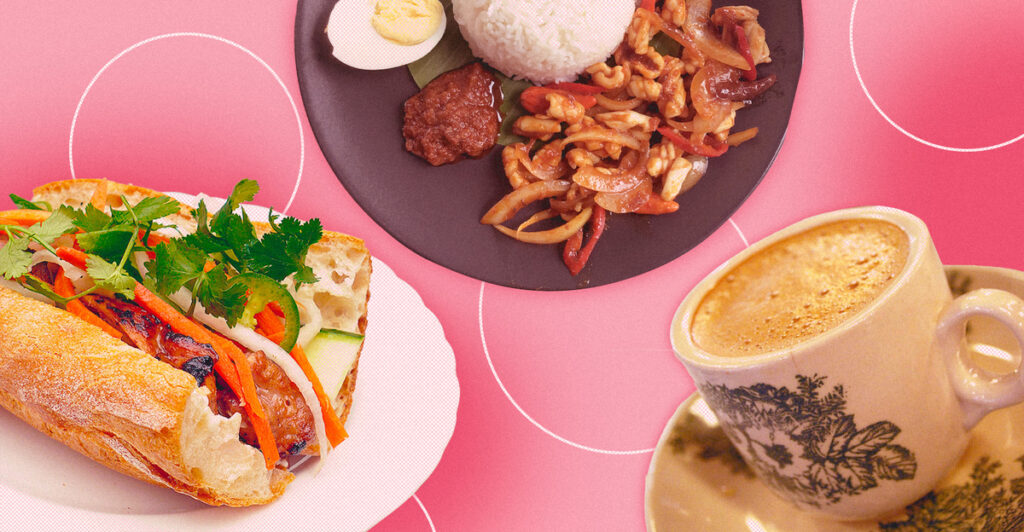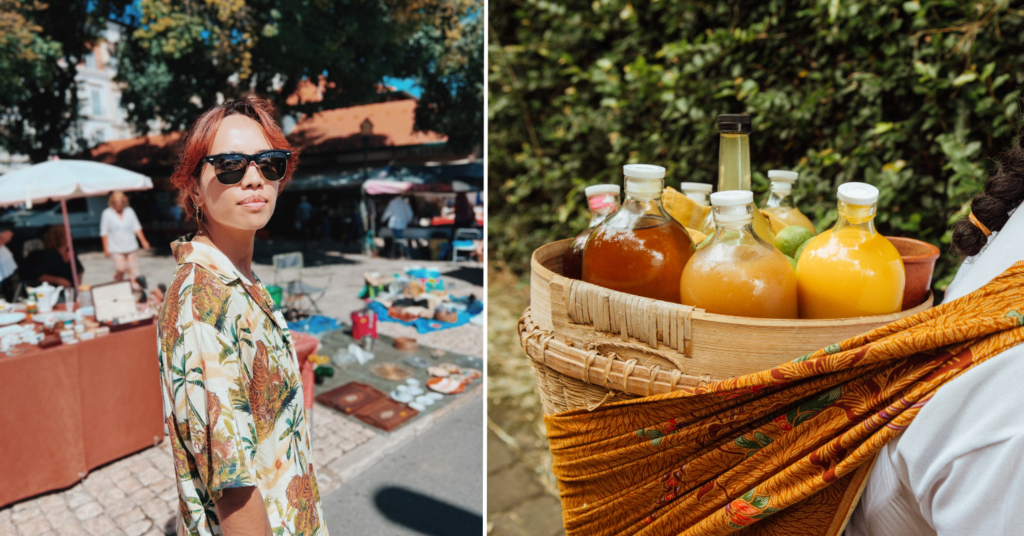EnVi Eatery: Breakfast, But Make It Southeast Asian

There is a saying that goes, “One way to have a fulfilling day is to have a good breakfast.” In Southeast Asia, breakfast takes on a unique and vibrant character. This region, known for its diverse cultures and rich culinary traditions, offers a fascinating display of breakfast foods that reflect the history, geography, and cultural tapestry of each country.
From street food stalls to home-cooked meals, breakfast in Southeast Asia is a delightful adventure, whether it’s enjoyed in a bustling kiosk or in a cozy home. Some of these dishes also have various twists, depending on the region and cater to the local palate. In this series of EnVi Eatery, we list some of the favorite South East Asian breakfasts that are beloved by locals.
In Between Kaya Toast and Morning Conversations: Singaporean Kopitiam
“One Set D, please!” You might hear this familiar phrase echoing throughout the place in the morning, which refers to a beloved menu item consisting of one kaya toast (toasted bread with sweet coconut jam), two half-boiled eggs, and kopi (coffee) or teh (tea) of your choice. The term “kopitiam” is derived from “kopi,” the Malay word for coffee, and “tiam,” the Taiwanese Hokkien word for shop, reflecting the country’s multiculturalism. In Singapore, these establishments serve as informal social hubs where people gather to enjoy affordable local cuisines and beverages.
The kopitiam culture in Singapore dates back to the early 20th century when Chinese immigrants, primarily from Hainan and Fujian, opened coffee shops serving traditional Chinese and local dishes. The old kopitiams you see nowadays have been passed down for many generations. One of the iconic, long-standing stalls is Tong Ah Eating House. Nestled in between peranakan-styled buildings in Keong Saik Road, Tong Ah Eating House has been serving kaya toast and kopi since 1939.
More than just a place to eat, a huge communal feeling lingers inside every kopitiam. Most older kopitiam places have stayed almost the same since when they first opened many years ago, instilling a nostalgic charm with simple wooden or marble top tables, rattan chairs, and open-air settings. The clinking of coffee cups, the aroma of freshly brewed kopi, and the buzz of animated conversations create an atmosphere that is both comforting and refreshing. Regulars are often greeted by name, fostering a sense of familiarity and warmth that transcends generations. The human connections forged in these humble settings are genuine and enduring, reflecting the shared cultural heritage and collective memories of the community. Whether it’s the elderly reminiscing about the past or youngsters discovering tradition, kopitiams serve as a living testament to the enduring spirit of togetherness and the simple joy of shared experiences.
Kopitiams have a unique way of ordering coffee and tea. There will be no lattes or macchiatos. You will have to learn the lingo of how to order a cup of kopi or teh, the kopitiam way.
If you want to order an iced coffee with evaporated milk and sugar, you have to say “Kopi C Peng.” Add an extra “dapao” if it’s a take-away order. The default menu is a hot coffee/tea with evaporated milk and sugar, so pay attention to details and don’t forget to mention your complete order!
The Nation’s Comfort Staple: Indonesian Bubur Ayam
Bubur ayam, or chicken congee, is a renowned comfort food for Indonesians. A staple that fits every mood but especially at breakfast time, bubur ayam often symbolizes the rise of the sun, just as the light casts its warmth. It’s commonly sold by street vendors in the morning, making it a convenient breakfast option for commuters. For many Indonesians, this dish evokes a familial sense of childhood and home. The dish’s simplicity makes it a favorite among all age groups.
Bubur ayam’s history dates back to the influence of Chinese congee, brought to Indonesia by Chinese immigrants. Over time, it has adapted to local tastes and ingredients. The combination of soft porridge with varied toppings creates a balanced and comforting dish, with contrasts in texture and complementary flavors. The congee itself has a mild, creamy taste, as the rice is cooked until it breaks down into a smooth yet thick consistency. This neutral base allows the toppings and broth to shine. On the other hand, the deep, savory flavor of the chicken broth, which is used to cook the rice, is enhanced by the addition of garlic, ginger, and occasionally lemongrass or galangal, giving the porridge a subtle aromatic undertone.
Different regions in the country serve different types of congee. In Jakarta, the Betawi-style chicken porridge often includes additional toppings like quail eggs and a more generous amount of soy sauce. Bandung’s version is known for its thick porridge and generous use of fried shallots. The Surabaya version features a lighter, more watery porridge with an emphasis on the freshness of the ingredients. Meanwhile, the Manado style from North Sulawesi incorporates various herbs and sometimes coconut milk, reflecting the region’s distinct flavors.
So, if you’re looking for a light yet fulfilling breakfast, a remedy to feeling cold, or a way to warm yourself on chilly nights, get some bubur ayam!
Malaysian Nasi Lemak Makes A Nourishing Breakfast
A quintessential part of Malaysian breakfast is a vibrant plate of nasi lemak. Nasi lemak, which translates to “rich rice,” derives its name from the creamy, coconut-infused rice that forms the heart of the dish. It is said that nasi lemak originated in the western part of the Malay Peninsula, specifically around Malacca, a historic trade center and culinary melting pot. This region, rich in coconuts and anchovies, provided the key ingredients for the creation of the dish.
The essential components of nasi lemak include coconut rice, which is rice cooked with coconut milk and pandan leaves, imparting a rich and fragrant aroma. Sambal, a spicy chili paste that varies in flavor and heat across different regions, adds a fiery kick to the dish. Ikan bilis, or fried anchovies, contribute a salty, crunchy element, while roasted peanuts provide additional crunch. Typically, nasi lemak is served with either a boiled or fried egg, and fresh cucumber slices offer a cooling contrast to the spicy sambal. Optional components that can enhance the dish include fried chicken or beef rendang, sambal sotong (squid coated in sambal), and fried or curried beef liver.
Different regions in Malaysia put their unique twist on nasi lemak. In Penang, known for its vibrant street food culture, nasi lemak often includes a variety of side dishes like curry chicken or fish. In Kelantan, it is frequently served with ayam percik (spiced grilled chicken) and a sweeter sambal. Johor’s version features a spicier sambal and sometimes includes fish cakes or otak-otak (grilled fish paste), adding to the dish’s regional diversity.
Oftentimes, you will most likely find nasi lemak at hawker stalls and markets. The dish also holds a special place in festive occasions and gatherings, symbolizing both daily comfort and celebratory indulgence.
The Crispy and Aromatic Vietnamese Bánh Mì
Imagine a busy morning in Ho Chi Minh City. As the sun rises, vendors set up their carts and the clatter of utensils and the sizzle of grilled meats fill the air. Locals and tourists alike flock to these stalls, drawn by the enticing scents and the promise of a delicious meal.
Vietnamese sandwiches are not your typical sandwich. Bánh mì, which translates to “wheat bread,” is a Vietnamese-style sandwich that was influenced by the French baguette but caters to Vietnamese taste. The history of bánh mì dates back to the late 19th century as a fusion of French and Vietnamese culinary traditions. The bánh mì is served with a flourish, layers of savory meats, fresh herbs, and crunchy pickled vegetables tucked into a warm, crusty baguette.
Fresh vegetables play a crucial role in bánh mì, such as ingredients like pickled carrots, daikon, sliced cucumbers, and fresh herbs like cilantro and green onions. The pickling process not only preserves the vegetables but also adds a tangy crunch that balances the richness of the meats and spreads. This emphasis on fresh, vibrant ingredients is a hallmark of Vietnamese cuisine, reflecting a focus on health and flavor.
Different regions in Vietnam put their unique spin on the bánh mì, showcasing local ingredients and preferences. For instance, in Hanoi, bánh mì is simpler with its grilled pork and fresh herbs, while in Hue, it can be more elaborate with various meats and spices. Coastal regions might include seafood, highlighting the diversity of Vietnam’s culinary landscape.
You can easily spot bánh mì in the bustling streets of Ho Chi Minh and Hanoi. Street vendors often serve bánh mì from small carts or stalls, creating a vibrant atmosphere where locals and tourists alike gather to enjoy this quick and flavorful meal. The communal aspect is enhanced by the shared experience of eating in public spaces, where people often stand or sit together.
Sweet Yet Comforting, Filipino Champorado
In the land of the Philippines, champorado (Filipino chocolate rice porridge) serves as a beloved dish that embodies comfort, nostalgia, and communal feelings. Champorado has its origins linked to the Galleon Trade between Mexico and the Philippines during the Spanish colonial period. The Mexican dish champurrado, a chocolate drink made with cornmeal, evolved into champorado when Filipinos adapted it by using glutinous rice instead.
Champorado is crafted from a few traditional ingredients that come together to create its rich flavor and comforting texture. At the heart of this dish is glutinous rice (or malagkit), which provides the characteristic creamy and thick consistency that makes champorado so satisfying. While other types of rice can be used, glutinous rice is preferred for its ability to absorb flavors beautifully. The chocolate flavor primarily derives from either cocoa powder or tablea, the latter beinga ball made of ground cacao beans. Tablea provides a richer and more authentic chocolate taste, while cocoa powder offers convenience. Sugar is added to sweeten the dish, allowing adjustments based on personal preference — some may enjoy a sweeter porridge than the others. Water is typically used to cook the rice and to dissolve the cocoa or tablea, but many recipes enhance the dish’s richness by incorporating evaporated milk or condensed milk for extra creaminess. A pinch of salt is sometimes included to elevate the overall flavor, balancing the sweetness and chocolate notes. Together, these ingredients create a comforting and nostalgic dish that is cherished in Filipino households.
One of the most distinctive features of champorado is its traditional pairing with dried salted fish (known as tuyo). This combination of sweet and salty flavors is a hallmark of Filipino cuisine, highlighting the cultural practice of balancing contrasting tastes. The salty fish complements the sweetness of the chocolate rice porridge, creating a harmonious dining experience that is both satisfying and rich in flavor.
For many Filipinos, champorado is a dish that is passed down through generations. Families often have their unique recipes or secret ingredients, making each version special and personal. The simple act of cooking champorado becomes a celebration of love, memory, and connection — a beautiful reminder that food has the power to unite families and preserve traditions across generations.
The Simplicity of Thailand’s Khao Tom
Khao tom is a traditional Thai rice soup that is widely recognized as a healthy and comforting breakfast due to its gentle flavors and warmth from the chicken broth. This aligns with the Thai culture that emphasizes food as a means of care and healing, reinforcing the notion that meals are not just about sustenance but also about nurturing relationships.
Khao tom is made using a few essential ingredients that contribute to its soothing flavor and texture. At its base is glutinous rice, which provides a creamy consistency as it cooks in water. The soup is typically flavored with garlic and ginger, which add warmth and depth to the broth. For protein, options such as shrimp, chicken, or pork are commonly included, enhancing the dish’s heartiness. Fish sauce is added for seasoning, imparting a savory umami flavor that is characteristic of Thai cuisine. Fresh herbs like green onions and cilantro are often used as garnishes, adding a burst of freshness and color to the dish. Some variations may also include mushrooms or vegetables, allowing for personalization based on regional preferences or individual tastes.
Different regions of Thailand have their unique takes on khao tom, influenced by local ingredients and culinary practices. For instance, in coastal areas, seafood is the primary protein, while in northern regions, the soup incorporates local herbs and spices. This regional diversity highlights the rich tapestry of Thai cuisine and the cultural significance of food as a reflection of local identities and traditions.
Curious about Turkish cuisine? Check out our Turkish Coffee spotlight here!



